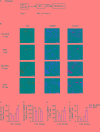Traumatic Stress Produces Distinct Activations of GABAergic and Glutamatergic Neurons in Amygdala
- PMID: 30186100
- PMCID: PMC6110940
- DOI: 10.3389/fnins.2018.00387
Traumatic Stress Produces Distinct Activations of GABAergic and Glutamatergic Neurons in Amygdala
Abstract
Posttraumatic stress disorder (PTSD) is an anxiety disorder characterized by intrusive recollections of a severe traumatic event and hyperarousal following exposure to the event. Human and animal studies have shown that the change of amygdala activity after traumatic stress may contribute to occurrences of some symptoms or behaviors of the patients or animals with PTSD. However, it is still unknown how the neuronal activation of different sub-regions in amygdala changes during the development of PTSD. In the present study, we used single prolonged stress (SPS) procedure to obtain the animal model of PTSD, and found that 1 day after SPS, there were normal anxiety behavior and extinction of fear memory in rats which were accompanied by a reduced proportion of activated glutamatergic neurons and increased proportion of activated GABAergic neurons in basolateral amygdala (BLA). About 10 days after SPS, we observed enhanced anxiety and impaired extinction of fear memory with increased activated both glutamatergic and GABAergic neurons in BLA and increased activated GABAergic neurons in central amygdala (CeA). These results indicate that during early and late phase after traumatic stress, distinct patterns of activation of glutamatergic neurons and GABAergic neurons are displayed in amygdala, which may be implicated in the development of PTSD.
Keywords: basolateral amygdala (BLA); central amygdala (CeA); neuronal activations; posttraumatic stress disorder (PTSD); single prolonged stress (SPS).
Figures




Similar articles
-
Traumatic Stress Produces Delayed Alterations of Synaptic Plasticity in Basolateral Amygdala.Front Psychol. 2019 Oct 25;10:2394. doi: 10.3389/fpsyg.2019.02394. eCollection 2019. Front Psychol. 2019. PMID: 31708835 Free PMC article.
-
Effects of single-prolonged stress on neurons and their afferent inputs in the amygdala.Neuroscience. 2008 Mar 27;152(3):703-12. doi: 10.1016/j.neuroscience.2007.12.028. Epub 2007 Dec 27. Neuroscience. 2008. PMID: 18308474
-
Glycyrrhizin Treatment Facilitates Extinction of Conditioned Fear Responses After a Single Prolonged Stress Exposure in Rats.Cell Physiol Biochem. 2018;45(6):2529-2539. doi: 10.1159/000488271. Epub 2018 Mar 16. Cell Physiol Biochem. 2018. PMID: 29558743
-
[Neurological mechanism and therapeutic strategy for posttraumatic stress disorders].Nihon Yakurigaku Zasshi. 2018;152(4):194-201. doi: 10.1254/fpj.152.194. Nihon Yakurigaku Zasshi. 2018. PMID: 30298841 Review. Japanese.
-
Single prolonged stress: toward an animal model of posttraumatic stress disorder.Depress Anxiety. 2009;26(12):1110-7. doi: 10.1002/da.20629. Depress Anxiety. 2009. PMID: 19918929 Review.
Cited by
-
Exploring gene-drug interactions for personalized treatment of post-traumatic stress disorder.Front Comput Neurosci. 2024 Jan 11;17:1307523. doi: 10.3389/fncom.2023.1307523. eCollection 2023. Front Comput Neurosci. 2024. PMID: 38274128 Free PMC article.
-
Post-retrieval Extinction Prevents Reconsolidation of Methamphetamine Memory Traces and Subsequent Reinstatement of Methamphetamine Seeking.Front Mol Neurosci. 2019 Jul 2;12:157. doi: 10.3389/fnmol.2019.00157. eCollection 2019. Front Mol Neurosci. 2019. PMID: 31312119 Free PMC article.
-
The Relationship between Post-Traumatic Stress Disorder Due to Brain Injury and Glutamate Intake: A Systematic Review.Nutrients. 2024 Mar 21;16(6):901. doi: 10.3390/nu16060901. Nutrients. 2024. PMID: 38542812 Free PMC article.
-
Emphasizing the Crosstalk Between Inflammatory and Neural Signaling in Post-traumatic Stress Disorder (PTSD).J Neuroimmune Pharmacol. 2023 Sep;18(3):248-266. doi: 10.1007/s11481-023-10064-z. Epub 2023 Apr 25. J Neuroimmune Pharmacol. 2023. PMID: 37097603 Free PMC article. Review.
-
Purinergic P2X7 receptor-mediated inflammation precedes PTSD-related behaviors in rats.Brain Behav Immun. 2023 May;110:107-118. doi: 10.1016/j.bbi.2023.02.015. Epub 2023 Feb 21. Brain Behav Immun. 2023. PMID: 36822379 Free PMC article.
References
-
- Alvarez-Dieppa A. C., Griffin K., Cavalier S., McIntyre C. K. (2016). Vagus nerve stimulation enhances extinction of conditioned fear in rats and modulates arc protein, CaMKII, and GluN2B-containing NMDA receptors in the basolateral amygdala. Neural Plast. 2016:4273280. 10.1155/2016/4273280 - DOI - PMC - PubMed
-
- APA (2000). Diagnostic and Statistical Manual of Mental Disorders fourth edition, Text revision (DSM-IV TR). Arlington, TX: American Psychiatric Association (APA).
-
- APA (2013a). Desk Reference to the Diagnostic Criteria from DSM-5™. Arlington, TX: American Psychiatric Association (APA).
-
- APA (2013b). Diagnostic and Statistical Manual of Mental Disorders: DSM-5, 5th Edn Arlington, TX: American Psychiatric Association (APA).
LinkOut - more resources
Full Text Sources
Other Literature Sources

